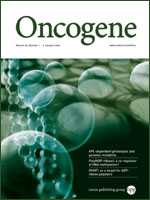Oncogene:β-catenin有抑制黑色素细胞迁移作用
2012-06-29 Beyond 生物谷
Wnt信号通路是一个复杂的蛋白质作用网络,其功能最常见于胚胎发育和癌症,但也参与成年动物的正常生理过程。 经典Wnt通路描述当Wnt蛋白于细胞表面Frizzled受体家族结合后的一系列反应,包括Dishevelled受体家族蛋白质的激活及最终细胞核内β-catenin水平的变化。 Dishevelled (DSH) 是细胞膜相关Wnt受体复合物的关键成分,它与Wnt结合后被激活,并抑制下游蛋白质
Wnt信号通路是一个复杂的蛋白质作用网络,其功能最常见于胚胎发育和癌症,但也参与成年动物的正常生理过程。
经典Wnt通路描述当Wnt蛋白于细胞表面Frizzled受体家族结合后的一系列反应,包括Dishevelled受体家族蛋白质的激活及最终细胞核内β-catenin水平的变化。 Dishevelled (DSH) 是细胞膜相关Wnt受体复合物的关键成分,它与Wnt结合后被激活,并抑制下游蛋白质复合物,包括axin、GSK-3、与APC蛋白。axin/GSK-3/APC 复合体可促进细胞内信号分子β-catenin的降解。当“β-catenin 降解复合物”被抑制后,胞浆内的β-catenin得以稳定存在,部分 β-catenin进入细胞核与TCF/LEF转录因子家族作用并促进特定基因的表达。
Wnt信号通路诱导β-catenin/lymphoid的增强因子转录因子。Wnt信号通路在各种癌症类型中都处于激活状态,Wnt激活后通过促进肿瘤细胞迁移侵袭,加剧肿瘤的转移。在黑色素瘤中,Wnt/β-catenin信号通路也处于激活状态,但在细胞核内β-catenin的存在似乎并不与这些肿瘤的侵袭性相关。
最新研究发现不同于刺激其他类型肿瘤细胞的迁移侵袭的阳性促进作用,β-catenin信号会导致黑色素细胞的迁移下降。在体内,β-连环素信号降低黑素细胞的迁移,β-catenin的抑制迁移作用依赖于MITF-M和CSK,MITF-M是黑色素细胞的关键转录因子,CSK是一个Src抑制剂。尽管减少迁移,在NRAS诱导的黑色素瘤小鼠模型β-catenin信号通路却促进肺转移。

doi:10.1038/onc.2012.229
PMC:
PMID:
Beta-catenin inhibits melanocyte migration but induces melanoma metastasis
S J Gallagher, F Rambow, M Kumasaka, D Champeval, A Bellacosa, V Delmas, and L Larue
The canonical Wnt signalling pathway induces the β-catenin/lymphoid enhancer factor transcription factors. It is activated in various cancers, most characteristically carcinomas, in which it promotes metastatic spread by increasing migration and/or invasion. The Wnt/β-catenin signalling pathway is frequently activated in melanoma, but the presence of β-catenin in the nucleus does not seem to be a sign of aggressiveness in these tumours. We found that, unlike its positive role in stimulating migration and invasion of carcinoma cells, β-catenin signalling decreased the migration of melanocytes and melanoma cell lines. In vivo, β-catenin signalling in melanoblasts reduced the migration of these cells, causing a white belly-spot phenotype. The inhibition by β-catenin of migration was dependent on MITF-M, a key transcription factor of the melanocyte lineage, and CSK, an Src-inhibitor. Despite reducing migration, β-catenin signalling promoted lung metastasis in the NRAS-driven melanoma murine model. Thus, β-catenin may have conflicting roles in the metastatic spread of melanoma, repressing migration while promoting metastasis. These results highlight that metastasis formation requires a series of successful cellular processes, any one of which may not be optimally efficient.
作者:Beyond
版权声明:
本网站所有注明“来源:梅斯医学”或“来源:MedSci原创”的文字、图片和音视频资料,版权均属于梅斯医学所有。非经授权,任何媒体、网站或个人不得转载,授权转载时须注明“来源:梅斯医学”。其它来源的文章系转载文章,本网所有转载文章系出于传递更多信息之目的,转载内容不代表本站立场。不希望被转载的媒体或个人可与我们联系,我们将立即进行删除处理。
在此留言







#Gene#
38
#迁移#
45
#色素#
40
#细胞迁移#
37
#Oncogene#
37